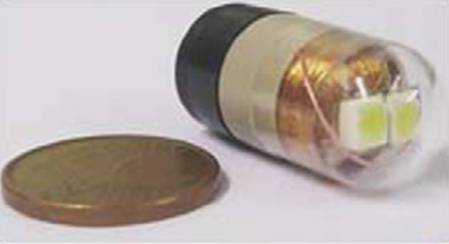|
Wireless Capsule Endoscopy
Future Directions
Research is underway to overcome the limitations of current capsule endoscopes.
External Power Sources
An external power source would eliminate reliance on battery power and therefore make possible improvements in resolution and frame rate. Work is underway to develop an inductive power link that will transmit energy wirelessly from a power source worn by the patient to the capsule [4]. This technology would involve a adding a power source and field generator to the data receiver belt the patient already wears. In place of a battery the capsule would contain a power receiver, a set of properly positioned inductors. Care must be taken to choose a power level and frequency that maximize the amount of power available to the capsule with out causing damage to the patient.

Lenaerts, B. and R. Puers (2007). "An inductive power link for a wireless endoscope." Biosensors and Bioelectronics 22(7): 1390-1395.
Image Compression
Onboard image compression could also help to improve resolution and frame rate with out adding to power consumption. Transmitting the image takes up a considerable amount of power and if this image could be compressed more power would be available for acquiring the image. However, the data compression itself must not use up more power than it saves [6].
Robotics
Perhaps the most exciting area of development in wireless capsule endoscopy is self propelled and autonomous capsules. These devices could move through the digestive tract independently of peristalsis. Olympus has been developing a capsule system that is controlled by three external magnets. The magnetic fields are varied to move the pill. Shape memory alloy actuators are also being explored as a possible means of locomotion. These would be controlled externally, by a physician or potentially by an onboard computer. Although autonomous motion would require more power than passive movement, less time and therefore energy would be wasted taking pictures of areas that are not of interest [6].
|

